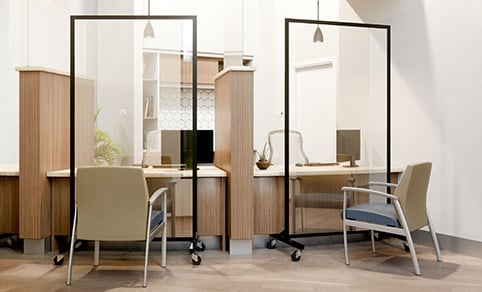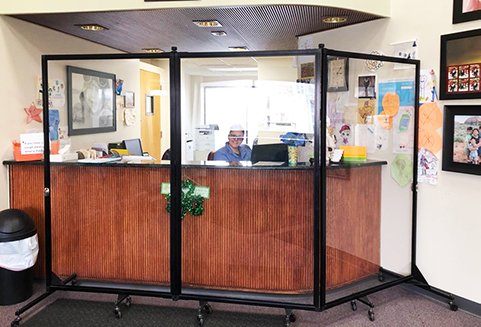Plexiglass: A Case Study of Clear Barriers
Market: Healthcare
In this new era, contagion is a common concern amongst the world’s population. Stores, hospitals, and more are coming up with better ways to prevent germs from spreading in light of the COVID-19 pandemic. The CDC Guidelines recommend installing physical barriers in reception areas as a way to continue running a business. What are most of these barriers typically made of? Plexiglass. Here’s how plexiglass material can be used during and after the global crisis.
 What is Plexiglass?
What is Plexiglass?
Plexiglass, or acrylic, materials are a shatter-resistant thermoplastic typically used as an alternative to glass. Even though the initial investment of plexiglass is more expensive than glass, it is still worthwhile for some cases. When the desired surface needs to be safer and less shatter-able, plexiglass is the best material. Plexiglass is less dense than glass, which is cheaper to ship. It is also more resistant to weathering and erosion than regular glass, making it longer lasting and ultimately more cost-efficient in the long run.
What is it Used For?
Windows and Greenhouses
There are many circumstances in which plexiglass material works best. While glass in windows panes still exists, plexiglass has increased in popularity in this situation. This material creates an excellent weather barrier, shielding the insides of homes from the outside elements. Since this material is also shatter-resistant, the windows are likely to last longer and not chip from overuse. Other sources have recommended using plexiglass material to construct a greenhouse as well. Along the same lines as window panes, greenhouse walls need to protect plants while still letting the sun through them.
Sneezeguards
Another purpose of plexiglass, especially in recent months, are sneeze guards. Before the COVID-19 pandemic, sneeze guards were primarily found in the grocery store at self-service produce or food stations. The use of acrylic sheets in this circumstance does precisely what it sounds like, to guard against sneezing (or coughing)! Having a barrier between humans and unpackaged food creates a shield against unwanted germs. 
Currently, in the times of the pandemic, this germ-preventing idea is evolving to protect humans from other humans. Now, sneezeguard-variations can be found at almost any facility still open in the world and will likely become the new normal. Grocery stores, pharmacies, gas stations, etc. all seem to have this plexiglass surface in some form or another. Restaurants, when open again to the public, will likely add the same to host stands as well. Plexiglass sneeze guards are the way of the future.
Plexiglass vs. Tempered Glass
Tempered glass is another similar product to plexiglass. This type of glass is stronger and more resistant to breaking than either glass or plexiglass. While plexiglass is useful for low impact areas such as a sneeze guard, tempered glass sheets are in areas at risk of more high impact. Car windows are a standard location for tempered glass for this reason. While these surfaces look the same, it all comes down to how they break apart. Tempered glass shatters into small, harmless pieces while glass creates large jagged shards that can create serious injuries.
Where to Buy See-Through Barriers
While there are many types of plexiglass products out there, the most versatile ones on the market are Screenflex Clear Dividers. What makes these partitions stand out from other acrylic barriers is that they are both freestanding and portable. By resting on self-leveling casters, the dividers can easily roll over various surfaces to any part of the hospital. Not only are these used at the reception area, but also any location that needs see-through walls. For instance, another area these screens can add value is surrounding a patient’s bed. The transparent barrier allows communication while ultimately protecting either side from germs.
Since plexiglass materials are going to be a considerable part of facilities reopening, it’s essential to know what materials work best for each scenario. Society may not reach where it was for some time, but clear barriers can help create a new normal that works for everyone.